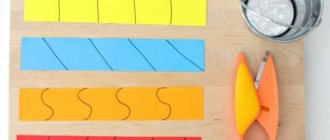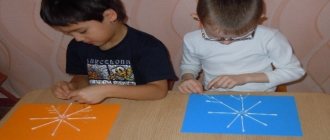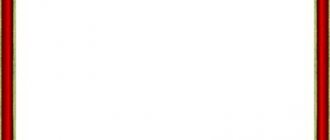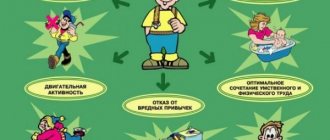Consultation for parents “Mathematics is interesting”
You often hear a child, approved by an adult, declare that he can count to 10, to 20. When he starts counting, he is in a hurry and misses numerals. The adults give him hints, and the child mechanically repeats everything they say. The question arises: Does the child really know how to count? Of course not. Here we see a mechanical memorization of numerals, behind which there is no main understanding. It is certainly necessary to teach preschoolers the basics of mathematics. This issue is especially acute now, when teachers and psychologists are tasked with creating the prerequisites for the transition to teaching children from the age of 6. A preschooler must be taught in such a way that the world around him becomes clearer.
Parents are called upon to help him with this, to show him significant interdependencies, to teach him to reason, compare, and contrast. Note that most parents, first of all, teach their children to count to 10, 20 and more. We'll have to upset them. Most often, such knowledge of children is useless, because the child has mechanically memorized the names and order of numerals and has practiced so-called abstract counting. As a rule, children have no idea of numbers.
How should you teach your child to count?
How to ensure that counting for him is not a set of words memorized in a certain order, but remains based on understanding the meaning of the number? Even in the younger group, the child learned to define different numbers of objects with the words “one” and “many.” At the age of 4 to 5 years, the kindergarten program provides training in counting to 5 based on comparison of 2 sets. So, for example, having homogeneous toys, you can show children that we have many animals, but among them 2 hares are less than 3 bears; 1 fox is less than 2 hares. There are many dolls. Offer to find out: “More small dolls or big ones.” Acquaintance with each new number is carried out on the basis of comparison of 2 sets. You place two rows of objects so that each of them is strictly one below the other. The child, comparing the number of objects, without counting, determines where there are more and where there are fewer. After this, you name the new numeral. There are 1 green cubes, and 2 red cubes. 2 is more than 1, 1 is less than 2. In the same way, introduce your child to the numbers 3, 4, 5.
Do not forget:
Our goal is to form a child’s understanding of numerals and the natural series of numbers by the beginning of school, and not just teach him how to count. To count, you need to take objects without distracting details, the objects must be interconnected (Christmas trees - mushrooms), (butterflies - flowers). Items should be familiar to children: buttons, sticks, etc. (no decorations). Show the children that it is more convenient to count objects with the right hand in the direction from left to right; while counting, each word - numeral must be related to only one object (the objects being counted are not named), teacher's demonstration. It is very important to teach the child to understand that “three” in this case does not refer to the name of the last object, but to the entire group of objects counted. You need to name objects, coordinating their name with the numeral in gender, number and case: “There are 2 cubes”, “There are only 3 apples”, “There are 5 mushrooms on the card”. First the numeral is called, then the noun. When a child learns to count objects, he can move them with his hand. Then you can move on to counting without moving your hand - visually.
For counting exercises, you can take different visual materials: toys, and later geometric shapes (circles, squares, triangles). Exercises need to be varied and set different tasks. For example: an adult puts 2 nesting dolls and 2 pyramids on the table. You ask: “How many nesting dolls are there?” How many pyramids are there here? “Which toys are there more? Less? How to make more pyramids? (does) Do it? How many pyramids are there? What toys are there fewer now? Why? How to make sure that there is an equal number of toys again.” Similar exercises can be done with different toys, outdoors and with natural materials: twigs, cones, pebbles, sticks, etc.
Focus on your children's actions
, the way they answer the questions you ask. Don’t rush your child and don’t rush to give advice yourself. Let the child develop his thinking and learn to be independent.
Show the children that the number does not depend on the size of the objects (2 adult chairs and 2 children's chairs, 3 large and 3 small dolls). Children often associate the number of objects with their spatial arrangement; they think that if some things take up a lot of space, then there are more of them in number than those that take up little space. The following exercises are needed: when you ask your child to count 2 groups of objects, arrange them differently.
For example:
in the top row there are 3 Christmas trees, located far from each other, and in the bottom row there are 4 fungi - closely located. What are more mushrooms or Christmas trees? How can you find out? You can count, or you can do it another way: put one mushroom under each Christmas tree, etc. teach your child to count or bring the number of objects you indicated: count out 3 buttons, bring the same number of cubes as I put on the table? Bring as many pyramids as I drew Christmas trees? It is useful to count objects by touch, with your eyes closed (how many potatoes are in the bowl? How many berries did mom put in her hand, etc.). Children will be happy to count the sounds: How many times did she clap her hands? How many times did you hit the drum with a stick? Place as many cubes as you want, how many sounds can you hear? You have to count out loud - 1, 2, 3.
To reinforce children’s quantitative concepts, play the following games with them:
- “WHAT HAPPENS IN 2?
Purpose of the game:
Practice children counting to 2.
Place 15 - 20 sticks on the table. The adult and the child take turns naming those items that always come in only 2 (shoes, stockings). For each correct answer, the player takes 2 sticks from the table.
Rules of the game:
1. If the answer is incorrect, you cannot take the chopsticks.
2. Each player counts the winning sticks independently.
3. The game ends when there are no sticks left on the table, then the players compare the method of applying the stick and determine the winner.
The game can be simplified: name objects, of which there can be 2: cucumbers, pencils, etc.
Make it more difficult: name something that does not exist in twos: paws on a cat, noses on a person, legs on a stool.
When the child gets acquainted with other numbers, you can play similar games: “What happens by 3, by 4.”
- "ORDER"
Purpose of the game:
Exercise children in the ability to count objects according to the named number.
The adult names a number familiar to the child, and the child brings the same number of toys. Then the child names the number, and the adult carries out the assignment. The correctness of the task is checked by the one who gave it. For each correctly completed task, the player receives a chip (small object). After the game, the number of chips collected is compared and the winner is determined.
Rules of the game:
1. The number is called only once.
2. The one who incorrectly fulfilled the order performs it a second time. An adult needs to make mistakes, but no more than by one (bring 5 items instead of 4).
Continue to teach children to distinguish and verbally indicate the size of objects. If the child is good at comparing the size of 2 objects, practice comparing the size of 3 objects.
Main attention
should be aimed at the size of the average object. The tale “The Three Bears” will help you well. Ask your child: Who is the biggest? Who is the smallest? How big is Nastasya Petrovna? Offer to choose chairs and dishes for them. Show your child 3 colored pencils of different lengths. Ask about the medium pencil. What is its length? (Medium) Long, short, shorter, longer - introduce these concepts.
Compare the thickness of books with different covers. It will be easier for the child to explain what book we are talking about.
Teach your child to arrange objects in descending order of their size: large, smaller, smallest, then in ascending order. To consolidate children's ideas about size, you can use modeling, drawing, and appliqué.
Sample tasks: sculpt three mushrooms of different sizes, draw a tall and a low tree, make a pyramid out of circles of different sizes, etc. Play the following games with the children:
- "SHOP"
Purpose of the game: to train children in the ability to distinguish the size of objects, to actively use the words in speech: long - short, low, wide, narrow, large - small.
Toys and objects of different sizes are selected for the game, for example: large and small dolls, long and short ribbons, wide and narrow cribs, high and low saucepans. The adult is the seller, the child is the buyer. To buy a toy, the child must name its size: “Please give me a long ruler,” “I need a tall pyramid,” etc.
The basic rule of the game: a toy or thing is given to the buyer only if its size is indicated.
- "PUT IN ORDER"
Purpose of the game:
to train children in the ability to arrange objects in descending or increasing order of their sizes.
There should be 10 - 15 objects of different sizes on the table (rings, pyramids, nesting dolls, paper mugs). At a signal, the adult and the child each take one object and arrange them by size (from smallest to largest and vice versa). The order of arrangement is agreed upon in advance. The winner is the one who, placing objects in a row, made fewer mistakes and completed his row faster.
Rules of the game:
1. Take one object at a time.
2. The selected item cannot be put back, but you can change its location in your row.
Children are already familiar with geometric shapes: circle, square, rectangle, triangle. Reinforce children's knowledge about shape in different types of activities: ask them to draw a square handkerchief, a rectangular towel, a quadrangular and a triangular flag. Teach children to correctly name the shapes used in construction: cube, cylinder, ball.
To reinforce children’s geometric concepts, play the following games:
- "FIND THE TRIANGLE"
Purpose of the game:
to train children in the ability to distinguish a triangle among other geometric shapes. Before the start of the game, each player has 15–20 different geometric shapes, including 8–10 triangles. At a signal, the players select triangles and place them in a row. The first one to select all the triangles wins. The game can be changed: choose squares, rectangles, circles.
- "WHO IS FASTER"
Purpose of the game:
exercise children in recognizing familiar geometric shapes.
Before the start of the game, each player has 10–20 pieces of different geometric shapes. They are mixed and covered with a sheet of paper. At the signal, each player opens his pieces and places them in a row: a row of squares, a row of circles, etc. The one who lays out 4 rows faster without mistakes wins.
Rule of the game:
start laying out figures only after the signal.
Continue to train children in the ability to navigate in space. The most convenient way to do this is in everyday life, giving the exercise a playful character or the form of an order: “Go to the sideboard and bring the cup that is on the right,” “what do you see to your right?” etc.
Children should be taught to navigate time, distinguish between parts of the day (morning, afternoon, evening, night); use words: today, yesterday, tomorrow, quickly, slowly.
Draw the children's attention to the changing parts of the day: evening is coming, it will soon be night, tomorrow we will go to the cinema. We read this book yesterday.
By age 5
children must distinguish and name: circle, square, rectangle, regardless of the size or color of the shapes. Distinguish and name a ball, cube, cylinder, correctly use words denoting spatial directions and time.
If you want to teach your child to count, buy 3 types of small toys, 10 pieces each (ducks, mushrooms, etc.) or choose from natural materials (pine cones, nuts, acorns, pebbles).
MAGAZINE Preschooler.RF
Consultation for parents “Mathematics for preschoolers”The main effort of both teachers and parents should be aimed at instilling in a preschooler the need to experience an interest in the very process of cognition, in overcoming difficulties, in independently finding solutions. It is important to cultivate and instill an interest in mathematics.
Acquaintance with size, shape, and spatial references begins in a child very early, already from infancy. At every step he is faced with the need to take into account the size and shape of objects, to correctly navigate in space, while for a long time he may not feel, for example, the need to count. Therefore, the knowledge that the child is most predisposed to assimilate is of paramount importance.
At preschool age, the foundations of the knowledge necessary
child at school. Mathematics is a complex science that
may cause some difficulties during schooling. In addition, not all children have an inclination and have a mathematical mindset, therefore, when preparing for school, it is important that preschoolers have the following knowledge in mathematics when they start studying:
- counting to ten in ascending and descending order;
- the ability to recognize numbers in a row and in sequence from one to ten;
- ability to form numbers of the first ten;
- recognize and depict basic geometric shapes (triangle, quadrangle, circle);
- the ability to divide an object into 2-4 equal parts;
- the child must be able to measure length, width, height using a string or sticks;
- comparing objects: more-smaller, wider-narrower, higher-lower.
In mathematics, it is not the quality of objects that is important, but their quantity.
Operations with numbers themselves are difficult at first and not entirely clear to the child. However, it is important to teach a preschooler to count using specific objects.
Games help your child become more comfortable with mathematics. In the process of playing, children learn complex mathematical concepts, learn to count, read and write, and the closest people - his parents - help the child develop these skills.
It is known that children really like doing small housework. Therefore, parents can teach their preschooler to count while doing homework together. For example, ask your child to bring you a certain amount of any items needed for the task. In the same way, you can teach your child to distinguish and compare objects: ask him to bring you a large salad bowl or a tray that is wider.
The kitchen is a great place to learn the basics of math. The child can count serving items while helping you set the table. Or, at your request, take three apples and one banana out of the refrigerator. You can diversify tasks endlessly.
Reading a book to a preschooler or telling fairy tales when they meet
numerals, ask him to put aside as many counting sticks as
for example, there were animals in history. After you have counted how many
there were animals in the fairy tale, ask who there were more, who were less, who
the same number. Compare toys by size: who is bigger?
a bunny or a bear, some smaller, some the same height.
Let your preschooler make up his own fairy tales with numerals.
Let the child say how many heroes there are in them, what they are like (who is bigger or smaller,
above and below), ask him to put aside the counting cards during the story
sticks. And then he can draw the heroes of his story and talk about them, make verbal portraits and compare them.
Very useful for developing a child's mathematical abilities
compare pictures that have both similarities and differences. Especially good
if the pictures have a different number of objects. Ask your preschooler how the pictures differ. Ask your child to draw different numbers of objects, things, animals, etc.
Draw children's attention to the shape of various objects in the world around them and their quantity. For example, the plates are round, the tablecloth is square, the clock is round. For older people: ask what shape this or that object resembles. Choose an object similar in shape to this or that figure. Ask what they have two of: two arms, two legs, two ears, two eyes, two feet, two elbows, let the child show them. And what one thing at a time.
Place the cups, ask how many plates, spoons and forks need to be placed if there are 3 or 4 people dining. Which side should the spoon and fork be on? They brought home fruits, apples and pears. What's more, you ask? What do I need to do. We remind you that this can be done without counting, by pairwise matching. If you count, you can compare the numbers (there are more pears, there are 5 of them, and there are fewer apples, there are 4 of them.) Cook the soup, ask how many vegetables are used, what shape and size they are.
On the way to kindergarten or home, look at the trees (higher, lower, thicker, thinner). Your child draws. Ask him about the length of the pencils, compare them in length, so that the child in life, in everyday life, uses words such as long-short, wide-narrow, high-low; thicker, thinner. It is important that these words are in children's vocabulary. The child must use the correct words for comparison by size by school.
Pay attention to the numbers that surround us in everyday life, in various situations, for example on a dial, in a calendar, in an advertising newspaper, on a telephone, a page in a book, the number of your house, apartment, car number.
Invite your child to look at the numbers on the phone with you, call them first in forward order, and then in reverse order, say your phone number; ask if the number has the same numbers. Ask to count as many items as the number shows, or show the number of how many buttons you have on your blouse.
Children learn not only to count, but also to navigate in space and time. Pay attention to this in your daily life. Ask your child what is to his left, to his right, in front and behind. Pay attention to when certain events occur, using the words: yesterday, today, tomorrow (what happened today, what happened yesterday and what will happen tomorrow). Call the day of the week, ask him; and what was yesterday will be tomorrow. Name the current month; if there are holidays or significant dates in this month, pay attention to this.
Introduce children to money and coins. So that the child knows how many rubles are contained in a particular coin, the number on the coin indicates the number of rubles, and the number of coins does not correspond to the number of rubles (money).
So, in a direct setting, sacrificing a small amount of time, you can introduce your child to many mathematical concepts, promote their better assimilation, maintaining and developing interest in mathematics.
| Next > |
An important task of modern pedagogy is the formation of a sufficient level of knowledge and skills of children, the achievement of state standards in various types of preschool institutions. Preschool institutions have accumulated sufficient experience in teaching and raising children and operate in accordance with modern requirements based on the achievements of psychological and pedagogical science.
The organization of the pedagogical process in groups of different ages has its own characteristics and difficulties; it requires the teacher to know the programs of all age groups, the ability to compare program requirements with the age and individual characteristics of children, the ability to correctly distribute attention, understand and see each child and the entire group in general, to ensure the development of children in accordance with their capabilities. It should also be noted those advantages that are characteristic specifically for a group of different ages: communication between younger children and older children creates favorable conditions for the formation of “advanced” knowledge (teacher-methodologist S.N. Lysenkova) and mutual learning. However, this can only be achieved with proper organization of training. Preschool pedagogy faces two vital problems: developing the most effective forms of planning education in preschool institutions and searching for forms and methods of teaching in groups with different age composition.
Characterizing educational work in a mixed-age group, all researchers (V.N. Avanesova, A.N. Davidchuk, E.G. Baturina, E.V. Rusakova, M.V. Minkina, etc.) indicate that it depends largely on the personal qualities of the teacher, his methodological training, and his ability to simultaneously manage the activities of children of different ages. The literature also contains some methodological recommendations for organizing classes in different age groups in kindergarten. For example, the authors offer two options for organizing collective classes: the beginning of the lesson simultaneously in all three (four) subgroups, and the end sequentially (after 15 minutes for the younger ones, after 20 for the middle ones, etc.); sequential start of the lesson (the lesson begins with one subgroup, then after 5-7 minutes the second joins, then the third).
Despite certain successes in resolving issues related to the organization of the educational process in small kindergartens (multi-age groups), there are still a number of unresolved problems. Therefore, educators of different age groups must be deeply aware of the specifics of this work.
The basis for work in mathematics in different age groups is the principle of a differentiated approach to teaching, which is carried out, firstly, taking into account the age of the children, and secondly, taking into account the level of mastery of mathematical knowledge, skills and abilities of each child individually. The teacher must study these levels of assimilation. The data obtained from such training makes it possible to determine the main pedagogical tasks in working with individual subgroups of children and outline ways to implement them, as well as constantly monitor the effectiveness of educational work.
The organization of work in subgroups in modern pedagogy is sometimes called “socio-game pedagogy”, or “socio-game approaches” in pedagogy (E.E. Shuleshko). Researchers recommend the number of children in microgroups from three to six. For each child in such a group, the most favorable conditions are created for the emergence of collective business communication. In such a micro-group there is less “psychological pressure” on the child, especially on the insecure and fearful one.
Of course, the most important area in organizing all the work on the formation of elementary mathematical concepts in a group of different ages is planning. The difficulties lie in the fact that the teacher must correctly combine the general requirements of didactics with the peculiarities of working in such groups.
In a multi-age group, as in a group with children of the same age, it is first of all necessary to ensure that each child masters the program content of each lesson. When developing a long-term plan for mathematics, the teacher proceeds from the need to strictly adhere to the connection between the presentation of new material, its repetition, consolidation and independent use by children in different types of activities.
The teacher carefully considers the content of each lesson, using such forms and methods of organization that could provide sufficient load for children in each age subgroup. As an example, we can take a group of children from 4 to 7 years old.
The teacher must determine in advance whether the educational material is sufficient and corresponds to the program objectives of the age subgroup, ensuring the correct selection of tasks for work under the guidance of the teacher and independent work of children.
It should also be noted that when planning work with all three subgroups simultaneously on one topic, the teacher must specify program tasks for each age group. For example, work is planned with all subgroups to consolidate knowledge about geometric shapes, but children of the fifth year of life must only find and name these shapes (square, circle, triangle, rectangle); children of the sixth year of life can also find and name a rhombus, be able to identify sides and angles, and children of the seventh year can compare these figures, find similarities and differences, describe a geometric figure, etc.
V.N. Avanesova proposed three types of organization of children in classes in a small kindergarten. Experience has shown the validity of this assumption in classes in a mixed-age group: I - all children are engaged in one type of activity, for example mathematics; II - combined classes; III - classes with one (preparatory) subgroup according to generally accepted methods. These classes ensure the correct implementation of the daily routine in a group of different ages, deep assimilation of knowledge, and influence the successful solution of educational problems.
Pedagogical experience makes it possible to diversify the options for each type of organization of classes (E.I. Shcherbakova, L.I. Shcherban). Taking these options into account when planning and organizing mathematics teaching in a mixed-age group contributes to the effective solution of program tasks for each age subgroup. Below is a description of possible options for each of the three types of mathematics classes in a mixed-age group.
Type I - all children are engaged in one type of activity - mathematics. This type provides a variety of options.
Option one: the start of classes at the same time, all three subgroups work on the same topic with complications for older children, then the children of the preparatory and senior subgroups are given an independent task, and the children of the middle subgroup work with a teacher (second half of the lesson). This concludes the lesson for children in the middle subgroup. The teacher moves on to the children of the older subgroup and works with them on the third program task. Having finished the lesson with them, the teacher continues to work with the children of the preparatory subgroup for another 5-8 minutes.
Option two: the beginning of the lesson is also simultaneous; in the first part of the lesson, all three subgroups work with the teacher on the same topic with complications for older children, then independent work is offered to the children of the middle and junior subgroups, and the children of the preparatory subgroup continue to work with the teacher. Having offered independent work to the children of the preparatory subgroup, the teacher sets aside 1.5-2 minutes to check the completion of the independent task by the children of the middle subgroup (the older ones continue to work independently at this time) and lets them go to play. After this, the teacher moves on to the children of the older subgroup, checks the completion of the independent task, works with them on solving the third program task, after which he lets them go to play, while he continues to work with the children of the preparatory subgroup.
Option three: in the first part of the lesson, the organization of children is the same as in the first and second options; In the second part of the lesson, the teacher works with children of the senior subgroup, and children of the middle and preparatory subgroups are engaged in independent work. In the third part of the lesson, the children of the senior subgroup work independently, and the teacher first checks the independent work of the children of the middle subgroup and lets them play, then checks the independent work of the children of the preparatory subgroup and works with them on solving the third program task. After this, the children of the preparatory group receive tasks for independent application of knowledge on the third program task, and they work independently, and the teacher takes 1.5-2 minutes to check the independent work of older children and lets them play. Classes end with checking the independent work of children in the preparatory group.
Option four is used mainly during tests and final classes. In the first part of the lesson, children of all three subgroups work together on one topic with more difficulty for older children; in the second part, all of them are offered independent tasks. Testing of independent work begins with the middle subgroup, after which the children go to play. Then the completion of an independent task by children in the senior and preparatory subgroups is checked. In the third part of the lesson, children of the senior and preparatory subgroups work together with the teacher on one topic with complications for children of the preparatory subgroup.
Option five: the lesson begins with children of the preparatory subgroup, after 7-10 minutes the children of the older subgroup are invited, and after another 5-7 minutes - of the middle subgroup. In the second part of the lesson, children in the preparatory subgroup are given a large amount of independent work for 12-14 minutes. These can be tasks using children’s productive activities: drawing, appliqué, design, etc. During this time, the teacher can work with children of the older subgroup and prepare them for independent work, invite children of the middle subgroup and spend time with them first part of the lesson. In the last part, all three subgroups work on the same topic with more difficulty for older subgroups.
Option six differs from the fifth in that in the last part of the lesson the teacher can give the children of the middle subgroup an independent task, and with the older and preparatory children he works on the same topic, after which they go to play, and the teacher checks the work of the middle school children. subgroups and finishes the lesson with them.
Option seven: the lesson begins with children from the preparatory group, after 5-7 minutes the older subgroup joins, and after another 5-7 minutes the middle group joins. While the preparatory group works independently to solve the second program problem, the teacher conducts the first part of the lesson with children of the older subgroup. Then the children of the middle, senior and preparatory subgroups work on the same topic. For children in the preparatory subgroup this task is the last, the third part of the lessons, for older children it is the second, and for children in the middle subgroup it is the first. After this, the children of the middle and senior subgroups work on a similar topic (one of the subgroups can be given independent work, while the other works with the teacher at this time).
Option eight: classes begin with children of the preparatory and senior subgroups. They work with the teacher on one topic with a complication for children of the seventh year of life. Children of the middle subgroup are invited to the lesson. Having solved the first problem together with the teacher, they begin to work independently. At this time, the teacher works with the children of the older subgroup, after which they go to play. The teacher allocates 2-3 minutes to check the independent work of children in the middle subgroup and lets them play. Work with children in the preparatory group for another 5-7 minutes.
Option nine: the lesson begins with children of the preparatory and senior subgroups. They work with the teacher on one topic with a complication for children of the seventh year of life. In the second part of the lesson, children in the preparatory subgroup work independently, and children in the older subgroup work with a teacher, or vice versa. Children from the middle subgroup are invited to the third part of the lesson; all three subgroups work on the same topic, with complications for children in older groups. Then the children of the senior and preparatory groups leave the lesson, and the teacher continues to work with the children of the middle subgroup.
In the first days, when organizing classes in a mixed group, the teacher can invite an assistant teacher or methodologist (head) to help. Over time, children get used to calm, quiet play, and the teacher does not need help. It should also be noted that at this time it is very good to offer children board games, building materials, etc. The correct placement of furniture in the room is of great importance. It is recommended to separate the play area with a special screen with indoor plants. This way, the play corner will be to the side, and the children who are playing will not distract the attention of those who are studying.
Experience shows that this type of organization of children in the classroom can be used periodically throughout the school year. At the same time, the activity of children in the lesson is ensured; children learn to perform individual tasks independently. As control checks at the end of the quarter and at the end of the school year showed, such an organization of classes ensures high-quality knowledge and skills of children.
Type II is a combined activity: two subgroups are engaged in mathematics, the third in visual arts, or vice versa.
Option one: the lesson begins with organizing visual activities with children in the middle subgroup. The teacher explains the task to the children and reminds them of the technical techniques for completing it. After making sure that the children have started working, the teacher begins a math lesson with children in the senior and preparatory subgroups. He conducts the first part of the lesson with them on one topic with a complication for children of the seventh year of life and gives tasks for independent work. At this time, the teacher provides individual assistance to children in the middle group, observing the work of everyone else. After reviewing the work of the children in the middle subgroup, the teacher continues to work with two subgroups. For children in the older subgroup, classes end 4-5 minutes earlier than in the preparatory group.
The second option differs from the first in that the associations of children vary. For example, children of the middle subgroup are busy with mathematics, and the senior and preparatory groups are busy with visual arts. This version of the lesson is held on the same day with a second lesson.
Option three: one of the subgroups is engaged in visual arts, but in other subgroups the mathematics lesson begins sequentially.
Classes of the second type enable the teacher to pay more attention to children doing mathematics. In addition, with the third option for organizing a lesson, it becomes possible to communicate new material to both subgroups.
It should also be noted that it is desirable to combine subgroups in different ways when organizing their mathematical activities. For example, in one week the senior and preparatory subgroups are united in mathematics, and in the next week the middle and senior or preparatory and secondary subgroups are united. This variation in the organization of the lesson contributes to a more complete assimilation of educational material by children.
Type III of children's organization is associated with an unequal number of mathematics classes for different age groups per week (for example, in the preparatory subgroup). Two options for organizing children in the classroom were identified.
Option one: classes with two subgroups - senior and preparatory.
Option two: the teacher conducts mathematics classes only with children of the preparatory subgroup according to generally accepted methods. At this time, if the kindergarten has a separate room or an insulated veranda, the music director conducts a music lesson or a physical education lesson with the children of the older group.
Options for this type of activity are usually simpler organizationally. That is why the teacher plans the most difficult topics for these classes, especially in the second option classes. As a rule, these classes present new material to children in the preparatory subgroup.
Such a number of options for organizing children in mathematics classes in a mixed-age group does not exclude the possibility of other options. It all depends on the specific program objectives of each lesson, on the children’s knowledge, their experience and, of course, on the teacher’s creativity. However, experience shows that the greatest effect on development comes from using not just one version of the developed activities, but their combination. The selection of didactic material for classes is of great importance. The teacher carefully thinks through and selects didactic material for each age subgroup, especially for children’s independent work.
Children's independent work should be interesting and challenging enough so that it forces them to think and find their own solutions. Simple tasks do not cause tension in the child’s thoughts and do not contribute to the development of cognitive-volitional activity. However, impossible tasks should not be allowed.
When planning a lesson, even an experienced teacher should at least briefly record its progress. The teacher must clearly know when and in what part of the lesson he works with this or that group of children. The effectiveness of children’s activities also depends on the clarity of the explanation of the task. The specifics of working in a multi-age group require differentiated consideration of children’s knowledge, which makes it possible to more clearly plan further individual work with children.
Completion of individual control tasks by children at the end of each quarter and at the end of the school year shows that children of all age groups, with proper organization of training, generally master the program material. The use of various options for organizing children in the classroom, the inclusion in the pedagogical process of various didactic games and exercises with individual children outside of class, during children’s independent activities, make it possible to pay sufficient attention to each child, taking into account his individual characteristics.
Article “Mathematics in kindergarten”
Thus, traditional educational games and modern technologies help children fall in love with mathematics.
Special requirements are also imposed on visual and handout materials. When preparing for a lesson, the teacher carefully considers in what part of the lesson and how this visual material will be used. It is necessary to dose visual material correctly. Both insufficient use and excess use of it have a negative impact on learning outcomes.
The main condition for the successful implementation of a program for the formation of elementary mathematical concepts is the creation of a developmental environment. According to the requirements of the Federal State Educational Standard, the development environment must be:
• content-rich,
• transformable;
• functional;
• variable;
• accessible;
• safe.
The saturation of the subject-developmental environment should be reasonable. Games should be appropriate to the age of the children and the tasks that are being solved at this stage. Shelves should not be cluttered with excess material. It is advisable to promptly replenish and change the subject-game environment with new games and gaming equipment. Of course, the accessibility of the content of the subject-development environment for children is also important.
Even in early childhood, babies encounter objects that differ in shape, color and quantity. At this age, the child’s basic elementary concepts and abilities begin to form.
The first toys resemble geometric shapes: cubes, construction sets, pyramids. The counting begins with mom’s questions: “Tell me, how old are you?” Parents teach children to name the shapes of toys, their size and quantity.
Through gaming activities, the ability to distinguish between different properties and features of objects is formed. The baby develops his first concept of mathematics, although he does not yet know or realize it. The consciousness of a child in early childhood is chaotic. Parents teach children to compare, group objects, and call them by their proper names. Through visual and objective actions, they help the child remember what he hears based on objective images. By the age of three, a child can already group objects according to their external characteristics, color, and shape. So, for example, a child can put green toys away from red ones, select pencils from a pile of other objects and put them together, can put pyramid rings according to size, in order. When engaging with objects through play activities, the child compares them. This is where the first acquaintance with mathematics begins.
The formation of mathematical concepts is not limited to one area of education; it is integrated with other types of activities. You could say that mathematics is everywhere.







